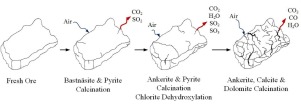当前位置:
X-MOL 学术
›
J. Ind. Eng. Chem.
›
论文详情
Our official English website, www.x-mol.net, welcomes your
feedback! (Note: you will need to create a separate account there.)
Production of Rare Earth Oxides from Raw Ore in Fluidized Bed Reactor
Journal of Industrial and Engineering Chemistry ( IF 5.9 ) Pub Date : 2020-05-01 , DOI: 10.1016/j.jiec.2020.01.034 Adrián Carrillo García , Mohammad Latifi , Said Samih , Jamal Chaouki
Journal of Industrial and Engineering Chemistry ( IF 5.9 ) Pub Date : 2020-05-01 , DOI: 10.1016/j.jiec.2020.01.034 Adrián Carrillo García , Mohammad Latifi , Said Samih , Jamal Chaouki

|
Abstract This study deals with the calcination of a rare earth bearing ore to produce rare earth oxides in a fluidized bed reactor, with the aim of demonstrating the advantage of calcining bigger particles to decompose stable minerals such as monazite by its mineral association within a particle. Rare earth oxides were produced by the decomposition of its bearing minerals, bastnasite and monazite along with the gangues. During the calcination, bastnasite decomposed at relatively low temperature while monazite reacted CaO at high temperature. The formation of cracks, revealed by BET and SEM analysis, allowed the particle’s degassing while the size remained constant, thus describing a crackling core behavior. The association of monazite to calcite for bigger particles (−60 mesh) allowed its decomposition to produce rare earth oxides with a monazite conversion of 50 %. Also, an extraction process comprised of calcination and mild acid leaching enriched the rare earth oxides in the ore by 3.34 and improved leaching efficiency of the gangues compared to smaller size (enrichment ration of 2.35). Using bigger particle sizes in the upstream process of a mining industry, i.e. comminution, can also reduce the energy consumption.
中文翻译:

原矿流化床反应器生产稀土氧化物
摘要 本研究涉及在流化床反应器中煅烧含稀土矿石以生产稀土氧化物,旨在证明煅烧较大颗粒以通过颗粒内的矿物缔合分解稳定矿物(如独居石)的优势。稀土氧化物是由其含有矿物、氟碳铈矿和独居石以及脉石分解产生的。在煅烧过程中,氟碳铈矿在相对较低的温度下分解,而独居石在高温下与 CaO 反应。BET 和 SEM 分析表明,裂纹的形成允许颗粒脱气,同时尺寸保持不变,从而描述了裂纹核心行为。独居石与方解石结合以获得更大的颗粒(-60 目)使其分解产生稀土氧化物,独居石转化率为 50%。此外,由煅烧和弱酸浸组成的提取过程使矿石中的稀土氧化物富集 3.34,与较小尺寸(富集比为 2.35)相比,脉石的浸出效率提高。在采矿业的上游过程(即粉碎)中使用更大的粒径也可以降低能源消耗。
更新日期:2020-05-01
中文翻译:

原矿流化床反应器生产稀土氧化物
摘要 本研究涉及在流化床反应器中煅烧含稀土矿石以生产稀土氧化物,旨在证明煅烧较大颗粒以通过颗粒内的矿物缔合分解稳定矿物(如独居石)的优势。稀土氧化物是由其含有矿物、氟碳铈矿和独居石以及脉石分解产生的。在煅烧过程中,氟碳铈矿在相对较低的温度下分解,而独居石在高温下与 CaO 反应。BET 和 SEM 分析表明,裂纹的形成允许颗粒脱气,同时尺寸保持不变,从而描述了裂纹核心行为。独居石与方解石结合以获得更大的颗粒(-60 目)使其分解产生稀土氧化物,独居石转化率为 50%。此外,由煅烧和弱酸浸组成的提取过程使矿石中的稀土氧化物富集 3.34,与较小尺寸(富集比为 2.35)相比,脉石的浸出效率提高。在采矿业的上游过程(即粉碎)中使用更大的粒径也可以降低能源消耗。











































 京公网安备 11010802027423号
京公网安备 11010802027423号